There were so many chapter books we loved this year, we couldn’t fit them all into one post. Here is part two of our favorite chapter books of 2014 for middle grades and young adult readers.
Part one of our list posted Dec. 15.
Middle Grades
Larson, Kirby. (2014). Dash. New York, NY: Scholastic Press.
 Readers can trust this author to deliver engaging, heart-wrenching historical fiction with likeable characters. Tracing the removal of the Kashino family from their home in Washington to a series of Japanese internment camps, the story begins after the attack on Pearl Harbor. Suddenly, everything changes, and 11-year-old Mitsi is bewildered by the attitude changes in her classmates and friends. It seems that she has no one left except her beloved dog, Dash. As she tries to come to terms with her friends' betrayal and the bigotry she sees all around her, word comes that all Japanese are to be rounded up and relocated. The family can only take a small number of possessions, and dogs are not allowed in the camps. Fortunately, an elderly neighbor, Mrs. Bowker, agrees to take in Dash. Young readers will feel their own hearts breaking at the separation, but then feel reassured once a series of letters from Dash arrive at the camp. The author provides insight into the fear and prejudices of that period in history while also describing the difficult conditions under which the internees suffered. Readers may have a clearer idea of what was happening stateside during WWII if they read this one alongside Larson’s earlier Duke (Scholastic, 2013) about the sacrifices a young boy makes during the same war.
Readers can trust this author to deliver engaging, heart-wrenching historical fiction with likeable characters. Tracing the removal of the Kashino family from their home in Washington to a series of Japanese internment camps, the story begins after the attack on Pearl Harbor. Suddenly, everything changes, and 11-year-old Mitsi is bewildered by the attitude changes in her classmates and friends. It seems that she has no one left except her beloved dog, Dash. As she tries to come to terms with her friends' betrayal and the bigotry she sees all around her, word comes that all Japanese are to be rounded up and relocated. The family can only take a small number of possessions, and dogs are not allowed in the camps. Fortunately, an elderly neighbor, Mrs. Bowker, agrees to take in Dash. Young readers will feel their own hearts breaking at the separation, but then feel reassured once a series of letters from Dash arrive at the camp. The author provides insight into the fear and prejudices of that period in history while also describing the difficult conditions under which the internees suffered. Readers may have a clearer idea of what was happening stateside during WWII if they read this one alongside Larson’s earlier Duke (Scholastic, 2013) about the sacrifices a young boy makes during the same war.
—Barbara A. Ward, Washington State University Pullman
Lovejoy, Sharon. (2014). Running Out of Night. New York, NY: Delacorte Books for Young Readers.
 An unlikely friendship forms between a 12-year-old white girl with no name—her family simply calls her Girl—and the runaway slave she befriends, Zenobia. Zenobia dubs her benefactor Lark. The girls set off in search of freedom since it's clear from her abusive treatment at the hands of her father and brothers that Lark, too, is enslaved in her own way. The girls must travel at night and hide and sleep by day since not only are Lark's family members in pursuit of her, but finding Zenobia means collecting a reward. Just when they reach a safe house and are preparing to head to the North, the worst thing that can possibly happen does, and once again, Lark, Zenobia, and Brightwell, another runaway slave with whom they have connected, find themselves in trouble with no help in sight. Each chapter begins with a proverb or wise saying linked to nature. Readers will be swept up by the drama and fast pace of this powerful debut novel. As Lark demonstrates, sometimes you have to leave the place with which you are most familiar as you search for freedom.
An unlikely friendship forms between a 12-year-old white girl with no name—her family simply calls her Girl—and the runaway slave she befriends, Zenobia. Zenobia dubs her benefactor Lark. The girls set off in search of freedom since it's clear from her abusive treatment at the hands of her father and brothers that Lark, too, is enslaved in her own way. The girls must travel at night and hide and sleep by day since not only are Lark's family members in pursuit of her, but finding Zenobia means collecting a reward. Just when they reach a safe house and are preparing to head to the North, the worst thing that can possibly happen does, and once again, Lark, Zenobia, and Brightwell, another runaway slave with whom they have connected, find themselves in trouble with no help in sight. Each chapter begins with a proverb or wise saying linked to nature. Readers will be swept up by the drama and fast pace of this powerful debut novel. As Lark demonstrates, sometimes you have to leave the place with which you are most familiar as you search for freedom.
—Barbara A. Ward, Washington State University Pullman
Prins, Marcel. (2014). Hidden Like Anne Frank: 14 True Stories of Survival. New York, NY: Scholastic/Arthur A. Levine Books.
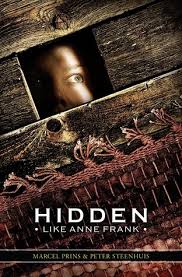 Anne Frank’s diary describing how her family hid from the Nazis fascinates middle graders who are shocked to learn that, in the end, she died in a concentration camp. This book tells the stories of 14 young Holocaust survivors who, like Anne Frank, went into hiding in the Netherlands during WWII. Some stayed with members of their extended families, but others stayed with strangers. While some of their benefactors were kind-hearted, often risking their own lives to help these children or teens, others were motivated by the money the Resistance movement provided for their care. Some found a safe place to stay for the duration of the war while others lived in as many as 15 or 45 different places. Several bonded with their surrogate or adopted parents and hardly knew their parents when they returned to claim them. Some lived knowing they survived, but the rest of their family did not. Survivor Donald de Marcas claims, “What followed was years of tears. A whole lifetime. That war will not be over until I take my last breath.” The stories vary in length, especially compelling because they are told in the individual voices of Holocaust survivors. Surprisingly, some even found love during this horrible time. Each story contains photographs and the back matter highlights a gallery of the survivors. Because the stories are so accessible and so brief, this book would be an excellent supplement to a Holocaust unit or one featuring Anne Frank or other stories about human rights violations. It is highly recommended.
Anne Frank’s diary describing how her family hid from the Nazis fascinates middle graders who are shocked to learn that, in the end, she died in a concentration camp. This book tells the stories of 14 young Holocaust survivors who, like Anne Frank, went into hiding in the Netherlands during WWII. Some stayed with members of their extended families, but others stayed with strangers. While some of their benefactors were kind-hearted, often risking their own lives to help these children or teens, others were motivated by the money the Resistance movement provided for their care. Some found a safe place to stay for the duration of the war while others lived in as many as 15 or 45 different places. Several bonded with their surrogate or adopted parents and hardly knew their parents when they returned to claim them. Some lived knowing they survived, but the rest of their family did not. Survivor Donald de Marcas claims, “What followed was years of tears. A whole lifetime. That war will not be over until I take my last breath.” The stories vary in length, especially compelling because they are told in the individual voices of Holocaust survivors. Surprisingly, some even found love during this horrible time. Each story contains photographs and the back matter highlights a gallery of the survivors. Because the stories are so accessible and so brief, this book would be an excellent supplement to a Holocaust unit or one featuring Anne Frank or other stories about human rights violations. It is highly recommended.
—Barbara A. Ward, Washington State University Pullman
Telgemeier, Raina. (2014). Sisters. New York, NY: Scholastic/Graphix.
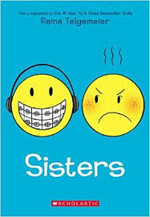 While few would dispute that sisterhood is powerful, being a good sister is difficult when the two siblings are as different as these two are. Drawing from her own childhood as she did in her debut title, Smile (Graphix, 2010), the author/illustrator describes an eventful road trip from San Francisco to Colorado during which the two come to terms with their differences. The book shifts from the road trip to earlier moments when Raina longs for a sister only to be horrified at how noisy her new sibling, Amara, turns out to be. The book also reveals some of the thorns of contention as the two compete for art prizes and deal with the death of various pets and their even-more crowded living conditions once their younger brother arrived. Some readers will smile in recognition at the way Raina shuts everyone out with her headphones and how Amara pitches so many fits and goes her own way, unconcerned about what others think about her. Still, the trip affords both girls glimmers of insight into how they might navigate a truce. Ultimately, they bond over the problems growing between their parents. Essential reading for anyone with a sibling or someone trying to make sense of family dynamics, this one will fly off the classroom book shelves.
While few would dispute that sisterhood is powerful, being a good sister is difficult when the two siblings are as different as these two are. Drawing from her own childhood as she did in her debut title, Smile (Graphix, 2010), the author/illustrator describes an eventful road trip from San Francisco to Colorado during which the two come to terms with their differences. The book shifts from the road trip to earlier moments when Raina longs for a sister only to be horrified at how noisy her new sibling, Amara, turns out to be. The book also reveals some of the thorns of contention as the two compete for art prizes and deal with the death of various pets and their even-more crowded living conditions once their younger brother arrived. Some readers will smile in recognition at the way Raina shuts everyone out with her headphones and how Amara pitches so many fits and goes her own way, unconcerned about what others think about her. Still, the trip affords both girls glimmers of insight into how they might navigate a truce. Ultimately, they bond over the problems growing between their parents. Essential reading for anyone with a sibling or someone trying to make sense of family dynamics, this one will fly off the classroom book shelves.
—Barbara A. Ward, Washington State University Pullman
Young Adult, Grades 9-12
Mathieu, Jennifer. (2014). The Truth About Alice. New York, NY: Roaring Brook Press.
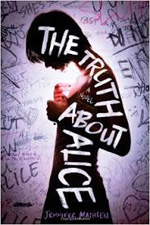 Many readers will recognize a girl like Alice Franklin—and maybe, if they're honest, they even added to her reputation as a bad girl or contributed to the rumors she was the school slut. Somewhat of a free spirit with plenty of time on her hands and little parental supervision, Alice begins sexual experimentation at an early age, but then, through a series of events that escalate after she refuses the advances of the star football quarterback, she becomes the victim of several rumors and comments written in bathroom stalls. As she becomes increasingly isolated, even her best friend forsakes her to maintain her own popularity and keep some distance. Surprisingly, the only student willing to spend any time with Alice is the school nerd, Kurt Morelli, who tutors her in math. Since the story of Alice's fall from grace is told from four points of view—Elaine, the class Teen Queen, Kelsie, Alice's former best friend, Josh, the best friend of Brandon, the quarterback, and Kurt—readers glimpse several versions of what happened to ruin Alice’s reputation as each one tries to justify his/her actions while keeping secrets. Every high school has an Alice, an attractive female whose reputation is damaged for one reason or the other, but the author’s decision to tackle the sexual double standards in our society add to this one’s thoughtfulness and make it ideal for class discussion. It's interesting to consider how willing many are to think only good of the heroes in our lives and only bad of the villains. And Alice has the last word in the end.
Many readers will recognize a girl like Alice Franklin—and maybe, if they're honest, they even added to her reputation as a bad girl or contributed to the rumors she was the school slut. Somewhat of a free spirit with plenty of time on her hands and little parental supervision, Alice begins sexual experimentation at an early age, but then, through a series of events that escalate after she refuses the advances of the star football quarterback, she becomes the victim of several rumors and comments written in bathroom stalls. As she becomes increasingly isolated, even her best friend forsakes her to maintain her own popularity and keep some distance. Surprisingly, the only student willing to spend any time with Alice is the school nerd, Kurt Morelli, who tutors her in math. Since the story of Alice's fall from grace is told from four points of view—Elaine, the class Teen Queen, Kelsie, Alice's former best friend, Josh, the best friend of Brandon, the quarterback, and Kurt—readers glimpse several versions of what happened to ruin Alice’s reputation as each one tries to justify his/her actions while keeping secrets. Every high school has an Alice, an attractive female whose reputation is damaged for one reason or the other, but the author’s decision to tackle the sexual double standards in our society add to this one’s thoughtfulness and make it ideal for class discussion. It's interesting to consider how willing many are to think only good of the heroes in our lives and only bad of the villains. And Alice has the last word in the end.
—Barbara A. Ward, Washington State University Pullman
O’Porter, Dawn. (2014). Paper Airplanes. New York, NY: Harry N. Abrams.
 This British import told from alternating points of view explores the unlikely friendship between two Guernsey teens during 1994 and 1995. Renee is the school prankster with a reputation for having many boyfriends and being sexually active. Flo is best friends with Sally, a girl who constantly puts her down and is so self-absorbed that she hardly pays attention to Flo. The girls have never really bonded, but when Flo's father dies unexpectedly, the two of them are drawn together because of their shared losses and their dysfunctional families. As the friendship grows, Flo still hangs onto her relationship with Sally and doesn't want to tell her that she and Renee are now friends. Renee also does damage to the relationship because of her attraction to Flo's older brother Julian who is a bit of a player. When the truth comes out, Flo is understandably destroyed, sure that Renee was never really her friend. There are various betrayals described in the book that make it realistic and enhance reader interest as well as complications provided by Renee's younger sister Nell who is dealing with an eating disorder. The helplessness and clueless of many of the adults in the girls' lives add to the book's authenticity and make the bond between Flo and Renee even more important.
This British import told from alternating points of view explores the unlikely friendship between two Guernsey teens during 1994 and 1995. Renee is the school prankster with a reputation for having many boyfriends and being sexually active. Flo is best friends with Sally, a girl who constantly puts her down and is so self-absorbed that she hardly pays attention to Flo. The girls have never really bonded, but when Flo's father dies unexpectedly, the two of them are drawn together because of their shared losses and their dysfunctional families. As the friendship grows, Flo still hangs onto her relationship with Sally and doesn't want to tell her that she and Renee are now friends. Renee also does damage to the relationship because of her attraction to Flo's older brother Julian who is a bit of a player. When the truth comes out, Flo is understandably destroyed, sure that Renee was never really her friend. There are various betrayals described in the book that make it realistic and enhance reader interest as well as complications provided by Renee's younger sister Nell who is dealing with an eating disorder. The helplessness and clueless of many of the adults in the girls' lives add to the book's authenticity and make the bond between Flo and Renee even more important.
—Barbara A. Ward, Washington State University Pullman
Pratt, Non. (2014). Trouble. New York, NY: Simon & Schuster Books for Young Readers.
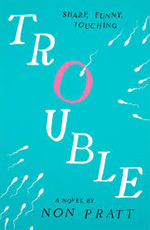 Both characters in this book have secrets about which the author drops hints throughout the book. Fifteen-year-old Hannah Shepard is pregnant, which is not all that surprising, given her reputation as being somewhat free with sexual favors. The school is rife with rumors about who the father might be. But Aaron, a new student at the high school, steps up to act as the surrogate father even though the two of them have never had sex. Alternating from both points of view—Hannah's and Aaron's—the book features a strong writing voice and complex characters. Plenty of mistakes and assumptions are made, and readers will feel empathy for both teens while also wondering about some of their decisions. Even Hannah's grandmother and Neville, the grumpy elderly man with whom Aaron spends time, are carefully drawn although the grandmother assumes less importance toward the book's conclusion. Readers will enjoy watching Aaron and Hannah take their first halting steps toward trusting each other even while vacillating in their feelings toward one another. Whether their relationship ever blossoms into a romance or not, what's most important is that finally, the two of them have someone on whom they truly can count.
Both characters in this book have secrets about which the author drops hints throughout the book. Fifteen-year-old Hannah Shepard is pregnant, which is not all that surprising, given her reputation as being somewhat free with sexual favors. The school is rife with rumors about who the father might be. But Aaron, a new student at the high school, steps up to act as the surrogate father even though the two of them have never had sex. Alternating from both points of view—Hannah's and Aaron's—the book features a strong writing voice and complex characters. Plenty of mistakes and assumptions are made, and readers will feel empathy for both teens while also wondering about some of their decisions. Even Hannah's grandmother and Neville, the grumpy elderly man with whom Aaron spends time, are carefully drawn although the grandmother assumes less importance toward the book's conclusion. Readers will enjoy watching Aaron and Hannah take their first halting steps toward trusting each other even while vacillating in their feelings toward one another. Whether their relationship ever blossoms into a romance or not, what's most important is that finally, the two of them have someone on whom they truly can count.
—Barbara A. Ward, Washington State University Pullman
Quintero, Isabel. (2014). Gabi, a Girl in Pieces. El Paso, TX: Cinco Puntos Press.
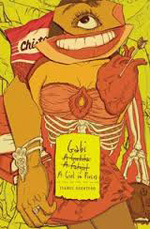 California high school senior Gabriella (Gabi) Hernandez is caught between not being Mexican enough and gravitating toward the things white girls do—at least according to her mother. To make sense of her world, she keeps a journal about her own struggles with self-esteem and related weight issues, also writing about her best friend Cindy's pregnancy and her other best friend Sebastian's coming out to his family. As if that weren't enough, she's caught up in the drama of multiple crushes and physical attraction toward the wrong guy. As she deals with mixed messages about how good girls behave, Gabi also keeps hoping that her father, a meth addict, will somehow manage to clean up his act. While the supporting cast with which Gabi is surrounded is strong, and her boyfriend turns out to be a good guy, it is Gabi herself who reveals strength and the determination not to let her circumstances define her. She is not a teen who needs saving, but one taking steps to save herself. Teen readers will love the inclusion of Gabi's poems and the illustrations in her zine and be pleased once she eventually finds her own voice. The author provides ample doses of humor and pathos in this marvelous book as each day provides another struggle with food choices and relatively unimportant choices as well as important decisions, depending on one’s perspective. So refreshing is Gabi's appetite for life that readers will be sad to reach the book's conclusion and have no more time to spend with her.
California high school senior Gabriella (Gabi) Hernandez is caught between not being Mexican enough and gravitating toward the things white girls do—at least according to her mother. To make sense of her world, she keeps a journal about her own struggles with self-esteem and related weight issues, also writing about her best friend Cindy's pregnancy and her other best friend Sebastian's coming out to his family. As if that weren't enough, she's caught up in the drama of multiple crushes and physical attraction toward the wrong guy. As she deals with mixed messages about how good girls behave, Gabi also keeps hoping that her father, a meth addict, will somehow manage to clean up his act. While the supporting cast with which Gabi is surrounded is strong, and her boyfriend turns out to be a good guy, it is Gabi herself who reveals strength and the determination not to let her circumstances define her. She is not a teen who needs saving, but one taking steps to save herself. Teen readers will love the inclusion of Gabi's poems and the illustrations in her zine and be pleased once she eventually finds her own voice. The author provides ample doses of humor and pathos in this marvelous book as each day provides another struggle with food choices and relatively unimportant choices as well as important decisions, depending on one’s perspective. So refreshing is Gabi's appetite for life that readers will be sad to reach the book's conclusion and have no more time to spend with her.
—Barbara A. Ward, Washington State University Pullman
Zail, Suzy. (2014). Playing for the Commandant. Somerville, MA: Candlewick Press.
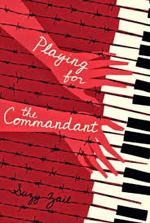 Hanna Mendel’s bright future as a concert pianist is quickly dimmed when the Nazis occupy Hungary. At first, her family lives alongside other Jews in a ghetto in Debrecen, but after they are transported to Auschwitz-Birkenau, Hanna and her older sister Erika do their best to survive after being separated from their parents. Hanna's former piano teacher spots her among the prisoners and suggests that she audition to play piano for the camp's commandant, a cruel man given to fits of rage. But the job also means more food to help the sisters survive so Hanna plays her heart out. While playing for the commandant and his guests, one of whom shows off a collection of teeth taken from the Jewish prisoners, Hanna comes to know the commandant's son, Karl Jager who is kind and increasingly upset about his father's cruelty. He does his best to help Hanna. As the Allied forces draw near and liberate the camp, Hanna is desperate to find her sister while also needing to hide as the Nazis desperately destroy as much evidence of their evil deeds as they possibly can. Readers will witness the harsh conditions of the concentration camps while also understanding how someone might be willing to do anything in order to survive. It's also worth considering how Karl manages to be totally unlike his father. The ending may surprise readers since the heart often disregards how others expect it to behave.
Hanna Mendel’s bright future as a concert pianist is quickly dimmed when the Nazis occupy Hungary. At first, her family lives alongside other Jews in a ghetto in Debrecen, but after they are transported to Auschwitz-Birkenau, Hanna and her older sister Erika do their best to survive after being separated from their parents. Hanna's former piano teacher spots her among the prisoners and suggests that she audition to play piano for the camp's commandant, a cruel man given to fits of rage. But the job also means more food to help the sisters survive so Hanna plays her heart out. While playing for the commandant and his guests, one of whom shows off a collection of teeth taken from the Jewish prisoners, Hanna comes to know the commandant's son, Karl Jager who is kind and increasingly upset about his father's cruelty. He does his best to help Hanna. As the Allied forces draw near and liberate the camp, Hanna is desperate to find her sister while also needing to hide as the Nazis desperately destroy as much evidence of their evil deeds as they possibly can. Readers will witness the harsh conditions of the concentration camps while also understanding how someone might be willing to do anything in order to survive. It's also worth considering how Karl manages to be totally unlike his father. The ending may surprise readers since the heart often disregards how others expect it to behave.
—Barbara A. Ward, Washington State University Pullman
These reviews are submitted by members of the International Reading Association's Children's Literature and Reading Special Interest Group (CL/R SIG) and are published weekly on Reading Today Online.